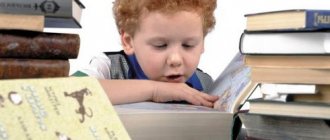Summary of a lesson on teaching literacy in the senior group with developmental disabilities on the topic:
Target:
formation of the foundations for successful acquisition of the Russian language, prevention of dysgraphia and dyslexia.
Tasks:
Educational:
1. Learn to determine the place of the sound “K” in a word (at the beginning, in the middle, at the end).
2. Continue to familiarize the child with the concept: “consonant sound”, “hard consonant sound”, “soft consonant sound”.
3. Learn to determine the presence or absence of sounds
and
k'
in the word (game "Chamomile").
4. Introduce the image of the letter K.
Correctional and developmental:
1. Develop phonemic awareness.
2. Develop logical thinking (analytical and synthetic activity).
3. Develop attention and memory.
4. Develop graphomotor skills.
5. Teach to clearly pronounce the sounds K and K', differentiate them by ear and in pronunciation.
6. Enrich your vocabulary.
7. Improve phonemic hearing, fine motor skills, and tactile sensations.
Educational:
1. Arouse the emotional mood of children for the lesson.
2. Cultivate perseverance.
3. Develop proper relationships with peers and adults.
4. Cultivate a love for your native language.
5. Increase speech activity.
6. Foster a culture of verbal communication.
Wellness:
1. Promote the development of general and fine motor skills and coordination of movements in children.
2. Teach muscle relaxation (during physical exercises).
3. Monitor children’s posture while working at the table.
Materials and equipment:
The letter K (“portrait of the sound K”), mirrors, sticks, a ball, a cube, plasticine boards, peas, a paper daisy with petal pictures, the names of which contain the sounds K and K’, colored pencils, leaves with objects.
Methods:
emotional mood, gaming motivation, verbal, visual, practical.
Techniques
: joint speech activity, introduction to an imaginary situation, physical education moment.
Progress of the lesson
1. Organizational moment.
Defectologist: Today a guest from ABC came to our lesson! Let's meet her.
Defectologist: Who is this?
Children's answer: This is a letter
Defectologist: That's right, it's a letter. But she didn’t come alone... Who came with her?
Children's answer: This is sound.
2. Main part.
Defectologist: The topic of our lesson is “Sound and the letter K.”
Defectologist: What kind of assistant object do we need to choose to name the sound K?
Assignment: Let us look at the objects that are on the tray and choose a helper. (At the request of the teacher, the student chooses the object that will help name this sound).
Children's actions: Choose the right mirror.
Defectologist: Why do we need a mirror? How will it help us?
Children's answer: You can make this sound in the mirror.
Task: children take mirrors.
Defectologist: Let us pronounce the sound K.
Defectologist: To do this, the lips and teeth are in a free position and the back of the tongue is only slightly raised towards the top (palate), and the tip of the tongue is lowered behind the lower teeth. We pronounce the sound K, and then softer - K '.
Children's actions: children pronounce the sounds K and K '.
Defectologist: What is this sound?
Children's answer: Consonant, it can be hard and soft.
Defectologist: In front of you are pieces of paper on which objects are depicted. You must find the object that begins with the sound K or K ' and color it in with a colored pencil.
Children's actions: Find the desired object and color it in independently using colored pencils.
Defectologist: Now let's
play the game "Chamomile" with these sounds.
Choose petals whose names contain the sounds K and K'. When you take a petal, do not forget to pronounce the word clearly, highlighting the sounds K and K' and determine their place in the word (at the beginning, in the middle, at the end). Children's actions: Children choose petal pictures whose names contain the sounds K and K', clearly pronounce the words, highlighting the sounds K and K', and find their place in the word.
Defectologist: Now it’s time for us to rest a little. But the letter K will also rest with us. She decided to teach us how to depict it in motion.
3. Physical education minute.
Defectologist: And now we will try to depict the letter K. To do this, you need to stand in a row. Then raise your right arm slightly up and lift your right leg off the floor (stand on one leg). Change position: raise your left arm slightly up, and lift your left leg off the floor (stand on one leg).
Children's actions: children sit in their seats
Defectologist: Guys, now you need to choose again the helper objects that will help you lay out the letter K. Let's choose them.
Children's actions: children choose peas, sticks
Defectologist: Guys, tell me, why did you choose peas and sticks?
Children's answer: Using these objects you can lay out the letter K.
Defectologist: Correct. But first, look at the letter K and tell me what elements it consists of?
Children's answer: From sticks
Defectologist: Count how many sticks she has?
Assignment: Children count: one, two, three.
Children's answer: Only three sticks
Defectologist: Well done. Right. Then let us try to lay out the letter K from the selected materials (samples are attached)
Children's actions: Using peas and sticks, children lay out the letter K on plasticine boards.
4. Summary of the lesson.
Defectologist: Guys, you did a great job today in class. Tell me, please, what sound and letter did we meet today? What sound is this?
Children's answer: Sound and letter K. The sound K is a consonant, hard, and K' is soft.
Defectologist: class is over.
Speech therapy session - hard and soft consonants
Corrective and developmental speech therapy session in a group to eliminate reading and writing disorders
Group: 2nd grade
Topic: Hard and soft consonants. The role of vowels a-z in indicating the hardness and softness of consonants.
Type of lesson: Consolidation of learned material
Goal: to consolidate the skill of indicating hardness of consonants with the vowel A, softness of consonants with the vowel Y.
Tasks:
I. Educational:
1. Consolidate the acquired knowledge about the role of vowels A-Z in the rejection and softening of consonants; 2. Achieve the assimilation of acquired knowledge on the topic as a result of developing skills in reading and writing syllables, words, sentences.
II. Correctional and developmental:
1. Provide conditions for the development of the operational component of educational activities:
a) mental operations:
- analysis and synthesis (when developing phonemic perception and representation skills, when performing tasks for the development of sound-letter analysis and synthesis);
- comparisons and generalizations (when identifying the role of vowels A-Z in the rejection-softening of consonants; when working on questions to clarify the lexical meaning of words; when naming objects by size from small to large);
b) provide conditions for the development of long-term memory through the designation of vowel sounds, hard and soft consonants with accepted symbols;
c) provide conditions for the development of the ability to distribute and switch attention at all stages of the lesson through the use of supporting visualization;
d) provide conditions for the development of students’ speech (when answering questions posed, when pronouncing poetic texts).
2. Provide conditions for the development of the motivational component of educational activities:
a) emotional motivation:
- through the game “Bear Cubs in the Forest School”;
- through the use of visual aids to the lesson.
b) cognitive motivation: - through resolving a problem situation during a game moment.
3. Provide conditions for the development of the regulatory component of educational activities:
a) when carrying out ongoing self-control at the stages of consolidating acquired knowledge, skills and abilities;
b) when switching from educational activity to a dynamic pause.
III. Educational:
1. To develop students’ communication skills:
- ability to listen to teacher instructions;
- the ability to comply with the norms of speech etiquette.
- 2. Nurture the personal qualities of students:
- the desire to provide assistance in a difficult situation;
- friendliness;
- accuracy when completing written assignments.
Hard and soft consonants. Distinguishing vowels A-Z (grade 2)
Order the original presentation: This e-mail address is being protected from spambots. You need JavaScript enabled to view it.
All presentations here
During the classes
1 Slide
1. Greeting children palm to palm in a circle.
2. Main part.
1) Message about the lesson: - Today in class we continue to learn to hear and distinguish between hard and soft consonants, to indicate the hardness and softness of consonants with vowels in writing and reading.
2 Slide
2) - Let's go into the forest and listen to the sounds. We listen carefully, raise our hand to answer, and answer while sitting.
- mosquito, - woodpecker, - bear.
The audio tag is not supported by your browser. . The audio tag is not supported by your browser. . The audio tag is not supported by your browser. .
- Well done! What are bear cubs called? (cubs)
3 Slide. The cubs went to study at Forest School. Of course it's difficult for them. I think we can help them. Really? -Bear cubs on the board. Look, the cubs put on jackets of different colors and each walked along their own path. A bear cub in a blue jacket walks over pebbles, and in a green jacket walks over lumps of cotton wool. And in their wicker backpacks they took the vowels A and Z. What vowel letter do you think each bear cub took? (in blue – A, in green – Z)
4 Slide
Let's read the syllables BA-BYA Let's remember the designation of vowels and sounds, hard and soft consonants with different symbols: Color: B blue TV, B green SOFT, A, I red VOICE. In writing: B line TV, B wave SOFT, A, Z - dot VOICE. Items: B pebble TV, B cotton wool SOFT. Gestures: Fist TV, pinch SOFT. CHARGING for fingers: fist-cotton, all fingers - fist-cotton, each finger in turn with the thumb.
Slide 5: Open your notebooks and write down today’s date “November 22.”
Slide 6: Let's help the cubs find and read paired syllables on daisies.
Slide 7: The bear cubs wished you their syllabic songs and wrote them down. Only vowel letters are marked with red squares. Don't forget that a bear cub in a blue jacket and a blue scarf sings roughly with hard consonants, and in a green jacket and scarf sings gently with soft consonants. Listen to the first song: LA-LA-LA and mark the hard and soft consonants with pebbles and cotton wool. Let’s check with our fingers and read the song from the syllables, naming the vowels: LA a -LA ya -LA ya. Write it down in your notebook and use a pencil to mark the vowels hard and soft. consonant sounds. Similar to NYA-NA-NYA, SA-SA-SA-SA.
8 Slide: Let's play the game “Wand-Rope”. Right hand, then left hand.
Slide 9: The cubs of other animals and birds came to the Forest School. Read who came to study. - Name domestic animals, domestic birds, wild animals, wild birds. - Write down the names of the cubs in your notebook.
Slide 10: Look how the cubs wrote the sentences. Let's read them. Let's fix the mistakes. Depending on the time, write 2 or 1 sentence, or the first and second as intended.
Slide 11: Well done! Results, assessments.
MKSOU for students and pupils with disabilities “Kstovo district special (correctional) general education boarding school of the VIII type” Teacher-speech therapist: Kukushkina Elena Nikolaevna
Also on topic:
Differentiation of vowels of the first and second series U-Yu




